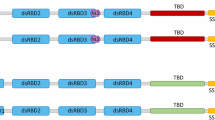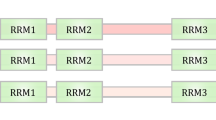Abstract
Human PRUNE is thought to enhance the metastasis of tumor cells. We found that a hypothetical paralog of PRUNE, PRUNE2, binds to 8-oxo-GTP, an oxidized form of GTP. Hypothetical PRUNE2 gene consists of C9orf65 and BMCC1/BNIPXL, both of which are malignant tumor-associated genes. We isolated PRUNE2 complementary DNA and revealed that the protein is composed of 3,062 residues. C9orf65 and BMCC1/BNIPXL encode the N-terminal part (259 residues) and C-terminal part (2,729 residues) of PRUNE2, respectively. We demonstrated the endogenous full-length PRUNE2 protein (338 kDa) by Western blot and mass spectrometry. PRUNE2 bound to 8-oxo-GTP as well as GTP. The expression levels of human PRUNE2 and mouse Prune2 messenger RNA (mRNA) were highest in the dorsal root ganglia (DRG) and, to a lesser extent, in other nerve tissues. DRG neurons express higher levels of PRUNE2 in their soma compared with adjacent cells. In addition, their expression levels in the adult nerve tissues were higher than those in fetal or neonatal nerve tissues. The present study indicates that C9orf65 and BMCC1/BNIPXL are transcribed as PRUNE2 mRNA, which is translated to a large PRUNE2 protein. The nerve tissue-specific and post-development expression of PRUNE2/Prune2 suggests that PRUNE2 may contribute to the maintenance of mature nervous systems.






Similar content being viewed by others
References
Altschul SF, Gish W, Miller W, Myers EW, Lipman DJ (1990) Basic local alignment search tool. J Mol Biol 215:403–410
Biedler JL, Helson L, Spengler BA (1973) Morphology and growth, tumorigenicity, and cytogenetics of human neuroblastoma cells in continuous culture. Cancer Res 33:2643–2652
Bowman AL, Catino DH, Strong JC, Randall WR, Kontrogianni-Konstantopoulos A, Bloch RJ (2008) The rho-guanine nucleotide exchange factor domain of obscurin regulates assembly of titin at the Z-disk through interactions with Ran binding protein 9. Mol Biol Cell 19:3782–3792
Clarke RA, Zhao Z, Guo AY et al (2009) New genomic structure for prostate cancer specific gene PCA3 within BMCC1: implications for prostate cancer detection and progression. PLoS ONE 4:e4995
D’Angelo A, Garzia L, Andre A et al (2004) Prune cAMP phosphodiesterase binds nm23-H1 and promotes cancer metastasis. Cancer Cell 5:137–149
Ford-Speelman DL, Roche JA, Bowman AL, Bloch RJ (2009) The rho-guanine nucleotide exchange factor domain of obscurin activates rhoA signaling in skeletal muscle. Mol Biol Cell 20:3905–3917
Iida T, Furuta A, Nakabeppu Y, Iwaki T (2004) Defense mechanism to oxidative DNA damage in glial cells. Neuropathology 24:125–130
Jalink K, van Corven EJ, Hengeveld T, Morii N, Narumiya S, Moolenaar WH (1994) Inhibition of lysophosphatidate- and thrombin-induced neurite retraction and neuronal cell rounding by ADP ribosylation of the small GTP-binding protein Rho. J Cell Biol 126:801–810
Kajitani K, Yamaguchi H, Dan Y, Furuichi M, Kang D, Nakabeppu Y (2006) MTH1, an oxidized purine nucleoside triphosphatase, suppresses the accumulation of oxidative damage of nucleic acids in the hippocampal microglia during kainate-induced excitotoxicity. J Neurosci 26:1688–1698
Larkin MA, Blackshields G, Brown NP et al (2007) Clustal W and Clustal X version 2.0. Bioinformatics 23:2947–2948
Lavin MF, Clarke R, Gardiner RA (2009) Differential expression of PCA3 and BMCC1 in prostate cancer. Prostate 69:1713–1714, author reply 1715
Machida T, Fujita T, Ooo ML et al (2006) Increased expression of proapoptotic BMCC1, a novel gene with the BNIP2 and Cdc42GAP homology (BCH) domain, is associated with favorable prognosis in human neuroblastomas. Oncogene 25:1931–1942
Mao M, Biery MC, Kobayashi SV et al (2004) T lymphocyte activation gene identification by coregulated expression on DNA microarrays. Genomics 83:989–999
Martinez-Ruiz G, Maldonado V, Ceballos-Cancino G, Grajeda JP, Melendez-Zajgla J (2008) Role of Smac/DIABLO in cancer progression. J Exp Clin Cancer Res 27:48
Nakabeppu Y, Nathans D (1991) A naturally occurring truncated form of FosB that inhibits Fos/Jun transcriptional activity. Cell 64:751–759
Nakabeppu Y, Kajitani K, Sakamoto K, Yamaguchi H, Tsuchimoto D (2006a) MTH1, an oxidized purine nucleoside triphosphatase, prevents the cytotoxicity and neurotoxicity of oxidized purine nucleotides. DNA Repair (Amst) 5:761–772
Nakabeppu Y, Sakumi K, Sakamoto K, Tsuchimoto D, Tsuzuki T, Nakatsu Y (2006b) Mutagenesis and carcinogenesis caused by the oxidation of nucleic acids. Biol Chem 387:373–379
Nonaka M, Tsuchimoto D, Sakumi K, Nakabeppu Y (2009) Mouse RS21-C6 is a mammalian 2′-deoxycytidine 5′-triphosphate pyrophosphohydrolase that prefers 5-iodocytosine. FEBS J 276:1654–1666
Perrelet D, Perrin FE, Liston P et al (2004) Motoneuron resistance to apoptotic cell death in vivo correlates with the ratio between X-linked inhibitor of apoptosis proteins (XIAPs) and its inhibitor, XIAP-associated factor 1. J Neurosci 24:3777–3785
Price ND, Trent J, El-Naggar AK et al (2007) Highly accurate two-gene classifier for differentiating gastrointestinal stromal tumors and leiomyosarcomas. Proc Natl Acad Sci USA 104:3414–3419
Soh UJ, Low BC (2008) BNIP2 extra long inhibits RhoA and cellular transformation by Lbc RhoGEF via its BCH domain. J Cell Sci 121:1739–1749
Tammenkoski M, Koivula K, Cusanelli E et al (2008) Human metastasis regulator protein H-prune is a short-chain exopolyphosphatase. Biochemistry 47:9707–9713
Torisu K, Tsuchimoto D, Ohnishi Y, Nakabeppu Y (2005) Hematopoietic tissue-specific expression of mouse Neil3 for endonuclease VIII-like protein. J Biochem 138:763–772
Tsuchimoto D, Sakai Y, Sakumi K et al (2001) Human APE2 protein is mostly localized in the nuclei and to some extent in the mitochondria, while nuclear APE2 is partly associated with proliferating cell nuclear antigen. Nucleic Acids Res 29:2349–2360
Wurst H, Kornberg A (1994) A soluble exopolyphosphatase of Saccharomyces cerevisiae. Purification and characterization. J Biol Chem 269:10996–11001
Acknowledgments
We thank Dr. Toru Iwaki for providing human tissue samples and helpful discussion. We thank Dr. Masaki Matsumoto from the Division of Proteomics of the Medical Institute of Bioregulation for helpful discussions. We thank Mizuho Oda, Emiko Koba, and Masumi Ohtsu from the Laboratory for Technical Support of the Medical Institute of Bioregulation and Setsuko Kitamura and Kazumi Asakawa for their technical assistance. This work was supported by MEXT KAKENHI 20013034, 21117512, JSPS KAKENHI 19390114, and by the Kyushu University Global COE program. T.I. is a research fellow of JSPS.
Author information
Authors and Affiliations
Corresponding author
Electronic Supplementary Materials
Below is the link to the electronic supplementary material.
ESM 1
Oligonucleotides used in this study (DOC 29 kb)
Rights and permissions
About this article
Cite this article
Iwama, E., Tsuchimoto, D., Iyama, T. et al. Cancer-Related PRUNE2 Protein Is Associated with Nucleotides and Is Highly Expressed in Mature Nerve Tissues. J Mol Neurosci 44, 103–114 (2011). https://doi.org/10.1007/s12031-010-9490-2
Received:
Accepted:
Published:
Issue Date:
DOI: https://doi.org/10.1007/s12031-010-9490-2




